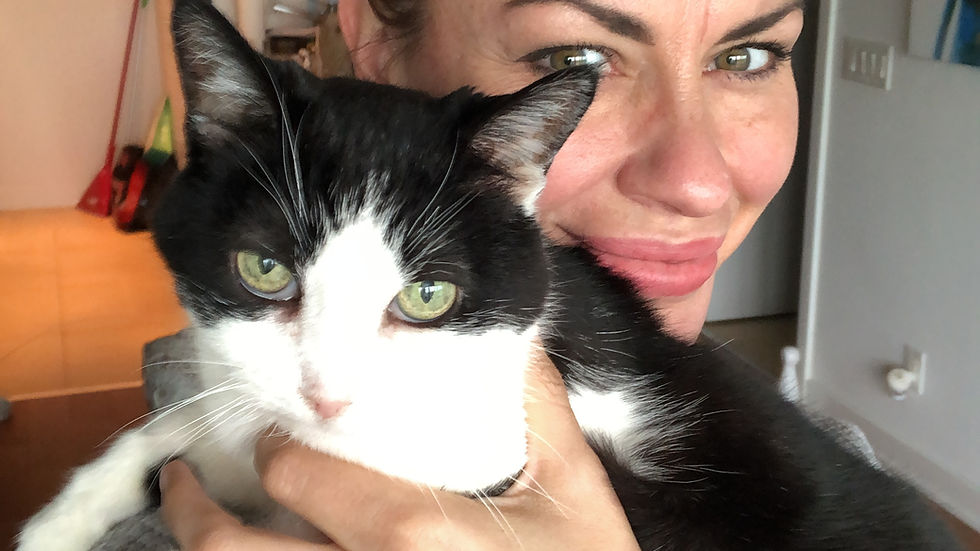Understanding Your Cat's Behavior: Insights from a Certified Cat Behaviour Consultant
- felinebehaviourcoa
- Oct 12
- 3 min read
Updated: Nov 3
I was absolutely thrilled to share my expertise as a Certified Cat Behaviour Consultant in a recent feature on Bored Panda. It was a fantastic opportunity to translate complex feline science into actionable, humanized advice, and I wanted to share the core insights right here with you.
Decoding Your Cat's Secret Language
If you caught the article, you know we focused on the fundamental truth: Our feline companions are not small, furry dogs. Their social structures, communication, and stress signals are unique, often subtle, and frequently misunderstood. Understanding these three keys is vital for any cat parent.
1. The Kitty Loaf: Your Cat's Ultimate "All Clear" Signal
We’ve all melted watching our cat transform into that perfectly symmetrical, four-paws-tucked-in kitty loaf. It's one of the cutest postures in the feline world, but did you know it’s also one of the clearest signs your cat is thriving?
This isn't just an adorable way to nap; it's a silent declaration of comfort and security. When a cat is "loaving," they are warm, relaxed, and feel zero need to make a quick escape. Their body language is communicating: “I am safe. I am content. The world is fine.” If you spot the loaf, give yourself a pat on the back—you’ve created a perfectly secure environment.

2. Territory and Scent Are Everything (The Resource Rule)
I often hear cat owners assume their feline friends operate under the same social rules as dogs. The truth is, cats are unique creatures. They are what we call facultative social animals—they can be social, but their core wiring is built around self-reliance and territory.
This is why scent and space are the foundations of feline happiness. Your cat’s bond to their environment is established by rubbing (bunting) and scratching, which mark their territory with their unique scent. They don't thrive on a social hierarchy or obedience training the way dogs do.
The most practical takeaway from this is simple: Distribute their resources. Don't concentrate all food, water, and litter boxes in one spot. Creating multiple feeding, drinking, and toileting stations (at least one per cat plus one extra) in separate, low-traffic areas dramatically reduces anxiety and territorial stress, especially in multi-cat homes. Think vertical and horizontal space—cats feel confident when they have options to survey their domain from above.

3. Zoomies, Hiding, and Peeing: Decoding Subtle Stress
One of the most frequent sources of stress for cat parents is unwanted behaviour, such as house soiling. This is where recognizing the subtlety of cat communication is crucial.
The Zoomies: Those sudden, frantic, full-speed runs aren't "bad behaviour"—they’re often an essential, overdue energy release. Your cat is hardwired for the "hunt, catch, kill, consume" sequence. If their daily play session hasn't fully satisfied that entire cycle, that pent-up predatory energy explodes into the famous "Zoomies" to clear the system. The fix is often more structured, satisfying play.
The Silent Red Flag: Unlike dogs, cats rarely give loud, obvious warning signs of stress. Their primary signals are subtle changes in routine, hiding more frequently, or, yes, litter box avoidance. Never mistake house soiling for defiance or "spite." It is almost always a physical sign of underlying stress or a medical issue.
Because cats are masters at masking illness (a survival behaviour in the wild), any sudden change warrants an immediate visit to your veterinarian first. Rule out the physical, and then we can look at the behavioural component.

Building a Stronger Bond with Your Cat
Understanding your cat's behavior is essential for creating a harmonious relationship. It’s not just about addressing unwanted behaviors; it’s about enriching their lives.
Enrichment Activities for Your Cat
Engaging your cat in play is crucial. Here are some ideas to enrich your cat's life:
Interactive Toys: Invest in toys that stimulate your cat's hunting instincts. Toys that mimic prey can be especially engaging.
Puzzle Feeders: These can provide mental stimulation while encouraging your cat to work for their food.
Cat Trees and Scratching Posts: Providing vertical space allows your cat to explore and feel secure.
Recognizing Stress Signals
Being aware of your cat's stress signals can help you act quickly. Look for changes in behavior, such as:
Increased hiding
Changes in appetite
Aggression or withdrawal
If you notice these signs, it’s essential to assess their environment and make necessary adjustments.
Conclusion
My passion is translating this fascinating feline science into practical, actionable advice. Whether you’re seeing unwanted behaviours or just looking to enrich your cat’s life, I’m here to help you decode those subtle signals so you and your cat can truly live in harmony.
Remember, understanding your cat's unique needs and behaviors is the first step toward a happier, healthier relationship. Let's work together to create a nurturing environment for your furry friend!






Comments